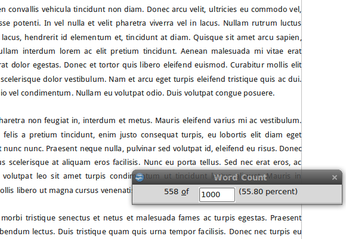Add Instant Word Count Feature to OpenOffice.org Writer

Productivity Sauce
While the Writer's Tools extension for OpenOffice.org is developed and maintained by your truly includes the Visual Word Count tool, it does have one serious drawback: it uses a modal window, i.e., you can't do anything until you close the Visual Word Count window. Fortunately, there is an alternative solution that solves that problem. The Live Word Count macro for OpenOffice.org is written in Python, so it uses a non-modal window which can be opened alongside the current document. To install the macro, create a folder called python in the /home/USER/.openoffice.org/3/user/Scripts directory (where USER is your actual user name), grab the latest version of the script and put it in the created folder. To run the macro, launch OpenOffice.org Writer and choose Tools | Macros | Run Macro. Select then My Macros | wc | wordCount and press the Run button.
Instead of navigating through the menus every single time you want to launch the macro, you can create a menu item for it. To do this, choose Tools | Customize and select the desired menu (e.g., Tools) from the Menu drop-down list in the Menus section. Press the Add button and select the OpenOffice.org Macros | My Macros | wc | wordCount macro. This adds the macro to the selected menu. You can then use the Up and Down buttons to move the created menu item. To change the item's name, press the Modify button, choose Rename, and give the menu item a descriptive name (e.g., Live Word Count). Press OK, and you are done.
Thanks to Leif Lodahl for the tip.
Comments
comments powered by DisqusSubscribe to our Linux Newsletters
Find Linux and Open Source Jobs
Subscribe to our ADMIN Newsletters
Support Our Work
Linux Magazine content is made possible with support from readers like you. Please consider contributing when you’ve found an article to be beneficial.

News
-
Manjaro 26.0 Primary Desktop Environments Default to Wayland
If you want to stick with X.Org, you'll be limited to the desktop environments you can choose.
-
Mozilla Plans to AI-ify Firefox
With a new CEO in control, Mozilla is doubling down on a strategy of trust, all the while leaning into AI.
-
Gnome Says No to AI-Generated Extensions
If you're a developer wanting to create a new Gnome extension, you'd best set aside that AI code generator, because the extension team will have none of that.
-
Parrot OS Switches to KDE Plasma Desktop
Yet another distro is making the move to the KDE Plasma desktop.
-
TUXEDO Announces Gemini 17
TUXEDO Computers has released the fourth generation of its Gemini laptop with plenty of updates.
-
Two New Distros Adopt Enlightenment
MX Moksha and AV Linux 25 join ranks with Bodhi Linux and embrace the Enlightenment desktop.
-
Solus Linux 4.8 Removes Python 2
Solus Linux 4.8 has been released with the latest Linux kernel, updated desktops, and a key removal.
-
Zorin OS 18 Hits over a Million Downloads
If you doubt Linux isn't gaining popularity, you only have to look at Zorin OS's download numbers.
-
TUXEDO Computers Scraps Snapdragon X1E-Based Laptop
Due to issues with a Snapdragon CPU, TUXEDO Computers has cancelled its plans to release a laptop based on this elite hardware.
-
Debian Unleashes Debian Libre Live
Debian Libre Live keeps your machine free of proprietary software.


Visual Word Count
Word count should be in the status bar.